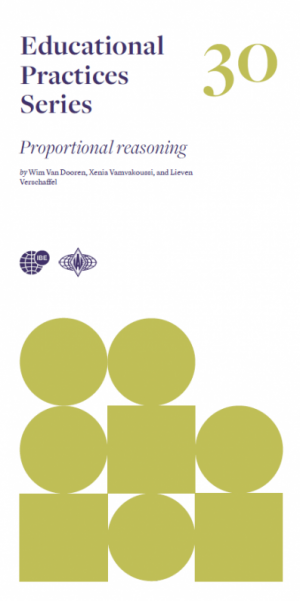Introduction
The middle school math curriculum (grades 5 to 8) contains many important mathematical notions. Still, proportionality can be considered among the most important ones. Mathematics educators suggest that the ability to reason proportionally deserves whatever time and effort that educators and students must invest to assure its development.
Proportionality is the capstone of elementary arithmetic, number, and measurement concepts, and at the same time one of the most elementary understandings one needs for more advanced mathematics. Understanding proportionality is not only essential for comprehending higher level mathematics such as geometrical similarity or probability, itis also most useful for everyday life.
The development of proportional reasoning is a complex process that progresses gradually over many years. However, despite the attention teachers pay to this area in the curriculum, students continue to experience many difficulties with it. In this research guide, we will address some of the most important difficulties and the ways to deal with them.
Proportional reasoning is situated in the multiplicative field. Two measure spaces are involved that are modelled by a linear function; i.e., a function of the form f(x) = ax. Consider the following example: When she makes strawberry jam, my grandmother uses 3.5 kg of sugar for 5 kg of strawberries. How much sugar does she need for 8 kg of strawberries? This example can be schematically represented as follows:
M1 M2
a b
c x
with the values a (5) and c (8) belonging to a first measure space M1 (strawberry weights), and b (3.5) and x (unknown) belonging to a second measure space M2 (sugar weights).
Proportional reasoning refers to the ability to understand, construct, and use the multiplicative relationship between the two co-varying measure spaces (which is called “functional reasoning”; see below) or within the measure spaces (called “scalar reasoning”; see below). This typically implies the multiplication and division operations, but, as will become clear throughout this guide, students can also fruitfully apply addition and subtraction to express and handle multiplicative relations.
The closely related term “multiplicative reasoning” is often used to refer to the less advanced types of reasoning required to solve simple, one-step multiplication and division problems, such as: Richard buys 4 cookies priced at 15 cents each. How much does he have to pay? Such problems are simple cases of proportional situations, as one of the four terms involved is equal to one, allowing one to solve the problem by a single multiplication.
Researchers generally distinguish two major types of proportional problems: missing value, and ratio comparison. We can consider the strawberry jam problem (given above) a missing-value problem in the sense that three of the four values in the proportion are given and the fourth one has to be calculated. One can turn it into a ratio comparison problem by changing it to: Yesterday, my grandmother made strawberry jam using 3.5 kg of sugar for 5 kg of strawberries. Today, she used 6.5 kg of sugar for 8 kg of strawberries. Which jam tasted sweeter?
In this research-based practice guide, we focus on missing-value problems, as these have received most attention in research. However, one could easily transfer most of the findings and educational implications to ratio comparison problems.
